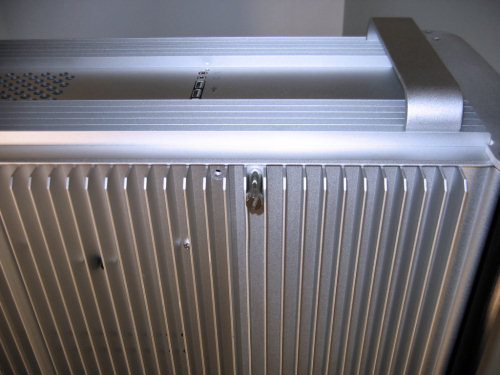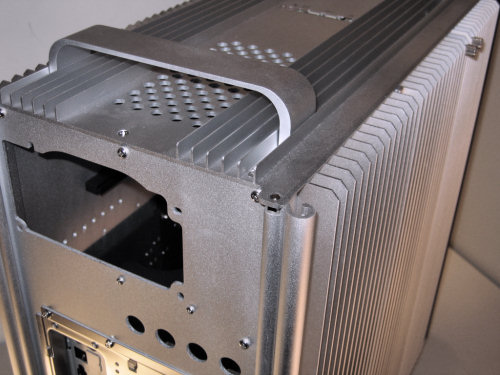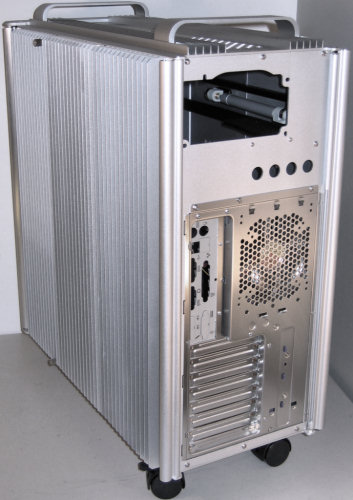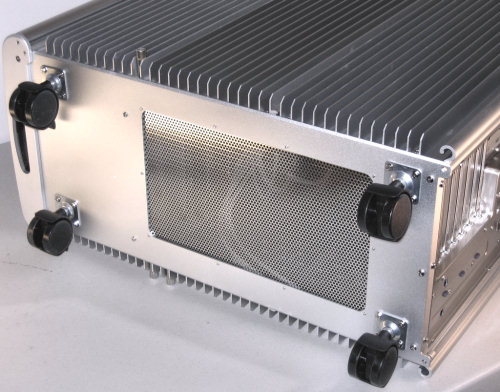Clash of the Titans - TT Tai Chi vs. CM Stacker 830
by Joshua Buss on February 23, 2006 12:05 AM EST- Posted in
- Cases/Cooling/PSUs
Thermaltake Tai Chi (cont’d)
An inch and a half long extended thumbscrews hold each part of the hinged door at the top and bottom, and since it's a double-hinge design on the left side, a total of four thumbscrews can be used – however, the front flap overlaps the main door and thus a single screw on the front panel at the top or bottom is the minimum needed to hold the side shut.
Moving further backwards, we can take a close look at the rear handle and rear backing plate. The thickness of the aluminum panels is very evident in this picture, as is the fact that the case can be completely separated into component parts and screws.
At first, this feature might seem rather unimportant, but the more that one thinks about it, the more obvious it is that to the enthusiast and even casual modder, this component nature is exceptionally valuable. For instance, the default ports visible in the back plate here for water cooling are 3/8” in diameter, which is fine for 3/8” O/D water tubing. However, 3/8” ID (inner diameter) tubing is pretty popular too, and without the ability to remove this plate from the rest of the case precisely enlarging these holes to the proper size would be much more difficult.
The over-sized rounded edges on the back resemble the look of the corners at the front of the case, but more importantly, they simply provide protection from the rest of the back of the computer and the rear-most fins of the side panels. Notice also how the rear of the case and the back of the motherboard area are completely separate, so that with a different motherboard standard such as BTX, all one needs to do is replace this back plate.
Turning the case on its side to inspect the bottom reveals that just as much attention to detail has been paid to it as the rest of the case. First off, notice that the heavy-duty casters are removable, should one decide they really would have the case take up less vertical space or simply have replacements that they'd rather use instead. When raised, however, the case benefits from the additional airflow capabilities of the hole in the front area and large perforated steel section. With the default casters left in place, a standard 120mm case fan can actually mount directly to this mesh from the bottom and still have enough clearance underneath it to function well.
Before opening the case, we really felt that this case deserved an extreme close-up to show off the immaculate finish and heavy thickness of the aluminum used.
The Tai Chi is really almost an entirely new kind of case, and the construction and sheer quality of materials used are some of the easiest ways to really see what we mean by this. In this photo, notice for instance how nice the contrast between the brushed finish of the front doors and the brilliant finish of the rest of the case look. Aesthetically, there simply isn't any other case to which to compare the Tai Chi – its marriage of passive radiation with other functionality-driven design choices gives it a unique, stately, and downright intimidating style that really requires seeing it in person to appreciate.
An inch and a half long extended thumbscrews hold each part of the hinged door at the top and bottom, and since it's a double-hinge design on the left side, a total of four thumbscrews can be used – however, the front flap overlaps the main door and thus a single screw on the front panel at the top or bottom is the minimum needed to hold the side shut.
Moving further backwards, we can take a close look at the rear handle and rear backing plate. The thickness of the aluminum panels is very evident in this picture, as is the fact that the case can be completely separated into component parts and screws.
At first, this feature might seem rather unimportant, but the more that one thinks about it, the more obvious it is that to the enthusiast and even casual modder, this component nature is exceptionally valuable. For instance, the default ports visible in the back plate here for water cooling are 3/8” in diameter, which is fine for 3/8” O/D water tubing. However, 3/8” ID (inner diameter) tubing is pretty popular too, and without the ability to remove this plate from the rest of the case precisely enlarging these holes to the proper size would be much more difficult.
The over-sized rounded edges on the back resemble the look of the corners at the front of the case, but more importantly, they simply provide protection from the rest of the back of the computer and the rear-most fins of the side panels. Notice also how the rear of the case and the back of the motherboard area are completely separate, so that with a different motherboard standard such as BTX, all one needs to do is replace this back plate.
Turning the case on its side to inspect the bottom reveals that just as much attention to detail has been paid to it as the rest of the case. First off, notice that the heavy-duty casters are removable, should one decide they really would have the case take up less vertical space or simply have replacements that they'd rather use instead. When raised, however, the case benefits from the additional airflow capabilities of the hole in the front area and large perforated steel section. With the default casters left in place, a standard 120mm case fan can actually mount directly to this mesh from the bottom and still have enough clearance underneath it to function well.
Before opening the case, we really felt that this case deserved an extreme close-up to show off the immaculate finish and heavy thickness of the aluminum used.
The Tai Chi is really almost an entirely new kind of case, and the construction and sheer quality of materials used are some of the easiest ways to really see what we mean by this. In this photo, notice for instance how nice the contrast between the brushed finish of the front doors and the brilliant finish of the rest of the case look. Aesthetically, there simply isn't any other case to which to compare the Tai Chi – its marriage of passive radiation with other functionality-driven design choices gives it a unique, stately, and downright intimidating style that really requires seeing it in person to appreciate.















55 Comments
View All Comments
JoshuaBuss - Thursday, February 23, 2006 - link
What about direct links to images? Does that work?http://images.anandtech.com/reviews/cases/roundups...">http://images.anandtech.com/reviews/cases/roundups...
Jojo7 - Thursday, February 23, 2006 - link
No.JoshuaBuss - Thursday, February 23, 2006 - link
Try a refresh. Sometimes the image server gets a bit bogged down.latino666 - Thursday, February 23, 2006 - link
Still can't get crap. I notice this problem also with the newegg article too. Man oh man did I want to see those pics.ATWindsor - Thursday, February 23, 2006 - link
The tai-chi has gigantic heat-sinks on the side, but to me they seem like little more then a gimmick. Almost nothing is in physical contact with them, and when they are only taking heat fom air, they seem to be virtually useless. I bet the diffrences if one had a "standard" side would be hardly measurable.The CM 830 surly is more ugly than the old model IMHO, It doesn't quit have that "large clean beast"-feeling anymore.
Cygni - Thursday, February 23, 2006 - link
It seems they were going for the look of the Zalman completly fanless case, but didnt bother to install the flush mount PSU or heatpipes that ran into the doors, haha. :p Oh well.Tamale - Thursday, February 23, 2006 - link
I'd call it a 'large techno beast' now ;)Howard - Thursday, February 23, 2006 - link
The 3/8" holes in the Tai Chi can easily be bored out with a twist drill bit (the regular ones) in a cordless drill. At least, they would be if the material is aluminum, and I think it is.JoshuaBuss - Thursday, February 23, 2006 - link
Yah, but it's still much easier when it can be taken apart and pieces can be worked on individually.Googer - Thursday, February 23, 2006 - link
Could you invert the motherboard on the CM Stacker by installing the tray on the left side in place of the usual right side? If you could possibly allow for better CPU cooling sine the processor would be sitting on the bottome getting plenty of cool air and allowing hot exhaust to escape upwards.